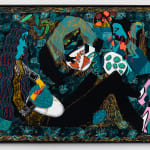


Summer Wheat b. 1977
176.5 x 242.6 cm
Further images
In these garden scenes Wheat continues to chew on the historical context of women in art. Luncheon on the Haystack references two major art works that shifted perspective from heroic genre painting to more contemporary subject matter and observation. The title references Manet’s Luncheon on the Grass and Monet’s Haystacks series. Both paintings referenced common objects or people during a time when subjects were heavily idealized or referencing history. Monet’s Haystacks depicted an everyday landscape contemporary to the artist through rigorous attention to color. Small dots of pigmented paint translate to the passage of time and the formation of light, shadow, and space. In Manet’s Luncheon on the Grass the juxtaposition of nude women and clothed men in contemporary attire generated scandal and subsequent public discourse because of the implication of female sex workers mingling with male elites. The figures in Luncheon On the Haystack pleasurably recline in a similar configuration on a patterned blanket while enjoying a picnic of vegetables. The woman in the foreground is wearing pants, much like the fashionable dandy in Manet’s lunch scene. There are no male chaperones here, and the liberated women continue to serve themselves and their children without caring about the attention of the viewer. Wheat’s rendering of Manet’s scene with female protagonists seeks to depict women in states of inner reflection where they are not nude and seeking attention from the viewer with eye contact. Her figures avoid being objectified and make it clear they are engaging in the consumption of food–we are not consuming them [ . . . ]
The women in Luncheon on the Haystack also have a light blue highlight on their faces suggesting a radiance coming from somewhere. The figures shine out of the dark black in bright jewel tones of ruby reds, green emeralds, and aquamarine or sapphire blues. Wheat’s electric palette symbolizes shifting energies and moods. Each color having its own personality but coming together to create a dynamic whole.


